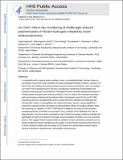UV-Vis/FT-NIR in situ monitoring of visible-light induced polymerization of PEGDA hydrogels initiated by eosin/triethanolamine/O₂
Author(s)
Wang, Chen; Bowman, Christopher N.; Stansbury, Jeffrey W.; Kaastrup, Kaja; Aguirre Soto, Hector Alan; Sikes Johnson, Hadley; ... Show more Show less
DownloadSikes_UV-Vis.pdf (905.1Kb)
OPEN_ACCESS_POLICY
Open Access Policy
Creative Commons Attribution-Noncommercial-Share Alike
Terms of use
Metadata
Show full item recordAbstract
In conjunction with a tertiary amine coinitiator, eosin, a photoreducible dye, has been shown to successfully circumvent oxygen inhibition in radical photopolymerization reactions. However, the role of O₂ in the initiation and polymerization processes remains inconclusive. Here, we employ a UV-Vis/FT-NIR analytical tool for real-time, simultaneous monitoring of chromophore and monomer reactive group concentrations to investigate the eosin-activated photopolymerization of PEGDA-based hydrogels under ambient conditions. First, we address the challenges associated with spectroscopic monitoring of the polymerization of hydrogels using UV-Vis and FT-NIR, proposing metrics for quantifying the extent of signal loss from reflection and scattering, and showing their relation to microgelation and network formation. Second, having established a method for extracting kinetic information by eliminating the effects of changing refractive index and scattering, the coupled UV-Vis/FT-NIR system is applied to the study of eosin-activated photopolymerization of PEGDA in the presence of O₂. Analysis of the inhibition time, rate of polymerization, and rate of eosin consumption under ambient and purged conditions indicates that regeneration of eosin in the presence of oxygen and consumption of oxygen occur via a nonchain process. This suggests that the uniquely high O₂ resilience is due to alternative processes such as energy transfer from photo-activated eosin to oxygen. Uncovering the intricacies of the role of O₂ in eosin-mediated initiation aids the design of O₂ resistant free radical polymerization systems relevant to photonics, optoelectronics, biomaterials, and biosensing.
Date issued
2015-11Department
Massachusetts Institute of Technology. Program in Polymers and Soft Matter; Massachusetts Institute of Technology. Department of Chemical EngineeringJournal
Polymer Chemistry
Publisher
Royal Society of Chemistry, The
Citation
Kaastrup, Kaja; Aguirre-Soto, Alan; Wang, Chen; Bowman, Christopher N.; Stansbury, Jeffrey W. and Sikes, Hadley D. “UV-Vis/FT-NIR in Situ Monitoring of Visible-Light Induced Polymerization of PEGDA Hydrogels Initiated by eosin/triethanolamine/O₂.” Polymer Chemistry 7, no. 3 (January 2016): 592–602 © 2016 The Royal Society of Chemistry
Version: Author's final manuscript
ISSN
1759-9954
1759-9962